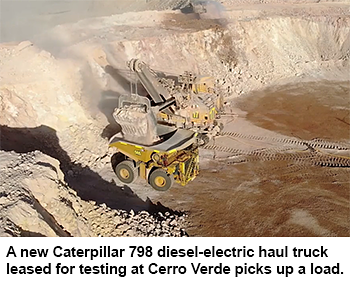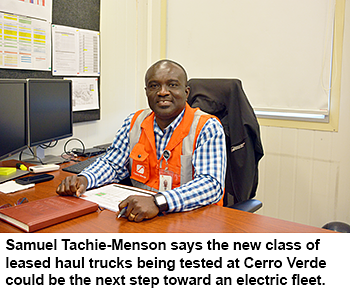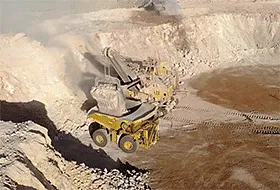(October 12, 2022) Testing of a new class of diesel-electric (D-E) haul trucks at Cerro Verde has the potential to reduce costs and clear traffic tie-ups at the mine in the near term while potentially setting the company up for an eventual transition to fully electric haul trucks when the technology is commercially viable.
An immediate aim of the trials is to determine the efficiency and economic advantages of ultra-class trucks and whether the heavier payloads in the new trucks will alleviate the congestion, which can bog down operations. These D-E haul trucks use an electric drive vs. a traditional mechanical drive and can add value through reduced fleet sizes that can support improved operating efficiencies and reduced unit costs. 
In addition, the D-E trucks also can provide a more flexible platform for the future as the company evaluates and considers enabling technologies, such as trolley assist. When D-E trucks are coupled with these technologies, the company estimates fuel consumption could be reduced by 20 to 30 percent, which is significantly lower than mechanical-drive trucks and could meaningfully support a decrease in greenhouse gas (GHG) emissions that come with it. That would be a major advancement in helping the company work toward its aspiration to participate in – and positively contribute to – a 2050 net zero economy.
The two-year tests are intended, in part, to determine if the heavier payloads of the D-E trucks make them more cost-effective, said Samuel Tachie-Menson, Engineering and Geology Manager-Cerro Verde. The new trucks can carry payloads of about 400 tons. A diesel-powered Caterpillar 793 haul truck, the workhorse of Freeport’s global fleet, has a payload of about 260 tons.
Traffic jams at Cerro Verde
The close confines of the mine make for a lot of congestion as its 147 haul trucks jockey for position on the roads in and out of the pit. Looking for ways to solve that problem led to testing of the new D-E trucks because of their bigger load capacity. Bigger loads mean fewer trucks and less congestion.
Beginning in October 2021, three Komatsu 980 E-5 trucks were leased to see how they would perform at the Peruvian site. Another four leased Caterpillar 798AC haul trucks also have been added to the fleet since May.
While economics and safely reducing traffic without sacrificing haulage capacity is the primary aim of the testing, the company also is interested to study how the new class of D-E trucks can help reduce GHG emissions both now and in the future, Tachie-Menson said.
For the short term, fuel consumption is being tracked by mileage and by tonnage moved. Even if the new D-E trucks get the same mileage as the smaller vehicles, they can move more tons and therefore would be more fuel efficient in terms of production.
“If they turn out to be more fuel efficient, that’s just an added bonus we will get,” Tachie-Menson said. 
Electrifying the future
The electric power trains in the new D-E trucks give them the potential to be a bridge between existing technology and fully electric haul trucks in the future.
In a D-E haul truck, the power train is driven by electricity generated by the diesel engine. These trucks have the potential to become fully electric since the engine’s only purpose is to generate electricity. All that is needed is an alternative power source.
The technology is not new. In fact, Cerro Verde already has 54 Komatsu 930 D-E trucks – many of them built in the 1990s – that operate the same way.
On the other hand, the technology needed for things like commercially viable battery-powered haul trucks could be a decade or more away, said Trevor Lewis, General Manager-Sustainable Mining. Even then, it is possible they will need some sort of power assist to be practical at company operations.
A mining operation that runs day and night cannot afford to have expensive haul trucks sitting idle for long periods while batteries are recharged or replaced. A power boost could be needed to help them out of the pit, and to recharge batteries while they are in operation.
Trolly technology to power innovation
One idea getting attention is setting up a trolly assist system using an electrified overhead cable to provide power directly to the haul truck. If successful, the new heavy D-E haul trucks from Komatsu and Caterpillar would be ideal for such a system, Lewis said. They likely would still need their diesel engines, at least for now. Trolly cables are best on long, straight stretches where the truck can maintain contact with the power line. Circular or winding roads like those leading into a mine pit are not ideal.
With the diesel engine intact, the trucks potentially could draw electricity from the power cable in the stretches where it is available and convert to diesel power where it is not, Lewis said. Eventually, batteries could replace the diesel engine when that technology improves.
Beyond the new trucks being tested, Cerro Verde’s existing fleet of the older Komatsu 930 D-E trucks might also be suitable for conversion to a trolly system.
The feasibility and cost of a trolly line at Cerro Verde still are being assessed, Tachie-Menson said. No decisions have been made. But the testing being done on the new class of D-E trucks gives the company a head start in embracing potential future electric haul truck technology needed to advance the company’s GHG production goals.
“Moving to the diesel-electric opens up huge opportunities for the use of future enabling technology,” Tachie-Menson said.
